
UNEXPECTED SYMPHONY
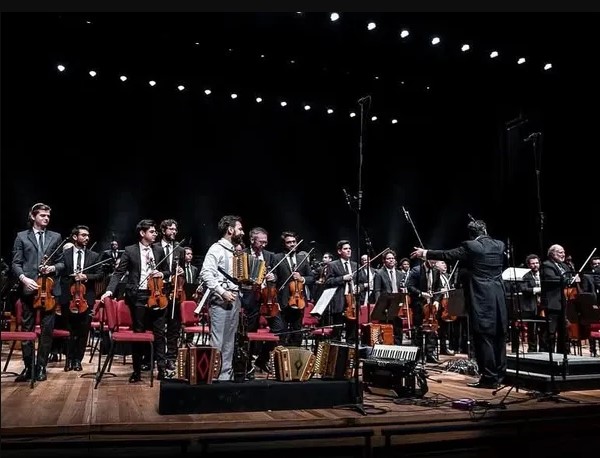
Concerto for Accordion and Orchestra
by João Pedro Teixeira Neto
From the silent corners of solitude and the storms of collective grief, I shaped this symphony—a mirror of our times, composed in silence and born in sound. When the pandemic crossed borders and invaded our lives, music became my voice.
Not just a concerto, this work is a conversation—not between soloist and accompaniment, but between breath and breath, soul and sound. The accordion does not isolate itself; it lives within the orchestra—sometimes whispering, sometimes weeping, sometimes rising in protest.
Divided into three movements, the work traverses a landscape of memory and emotion. Each moment, though marked by pain, is permeated with beauty.
Title: Unexpected Symphony — Concerto for Accordion and Orchestra
I – THE PANDEMIC
II – AFRICAN HERITAGE
III – BRAZIL IN FLAMES / IN SEARCH OF A CURE
Divided into three movements, the work traverses a landscape of memory and emotion. Each moment, though marked by pain, is permeated with beauty. This is our story, sung in three chapters:
A Poetic Odyssey for Accordion and Orchestra — Echoes of a Transformed World. Composed, arranged, and orchestrated by João Pedro Teixeira
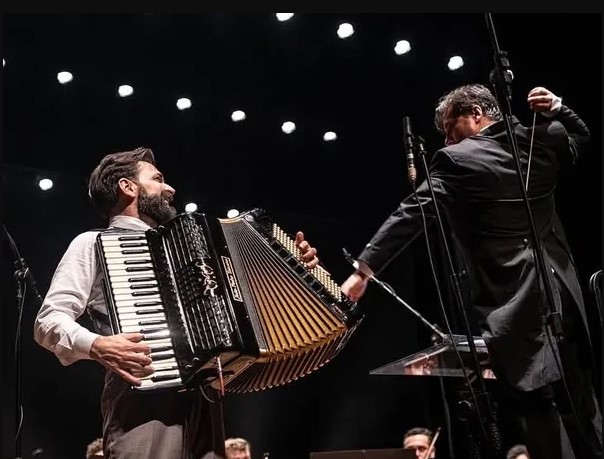
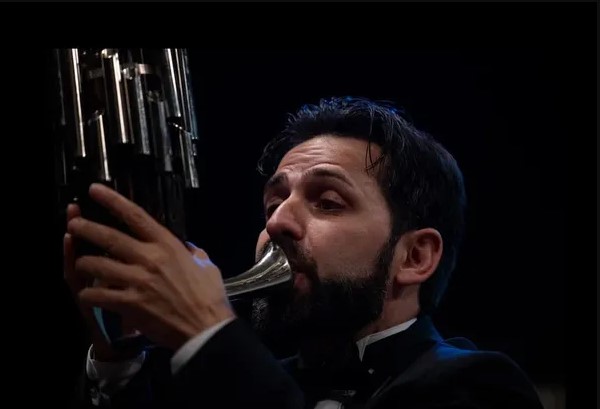
I – THE PANDEMIC
A single breath—trembling, ancient—opens the piece. The Sheng, the Chinese ancestor of the accordion, hums the first warning. A quiet, wavering sound—like a ripple before a storm. Strings hold their breath. Bassoons and glockenspiel play nervous triplets. And then it spreads:
“From Wuhan to the World,”
“Hosts”—the virus finds us.
We arrive in Lombardy. I pick up the Italian Organetto, quoting a tarantella. It dances—but mourns. The English horn echoes in mourning, and the strings lull us into veils of mourning.
“Beyond Comprehension” is the name I gave this moment. A celebration interrupted. A song cut off mid-sentence.
A horn sounds—a lonely future disappearing.
“Leaving the future behind.”
Then, the ICU speaks.
“Vital Sounds”—I transcribed the voices of machines, the rhythms of survival. Beeps. Pulsations. The language of life, held by a thread. The orchestra becomes a hospital room, and the accordion, its silent beat.
Death arrives—not with fear, but with mystery.
“The Transition,”
“The Passage.”
I imagined what cannot be known.
And then came Mourning. The diatonic accordion screams in melody, supported by bells, timpani, strings—all breathing as one.
A final Tutti emerges—urgent, desperate.
“Final Alert.”
II – AFRICAN HERITAGE
This movement was born from fire—related injustices against Black Americans. Fires in many American cities lit a flame that illuminated the world.
In that flame, I found our roots.
A Cajun accordion sings a melancholic solo—nine measures of memory.
The double bass responds in the shadows, anchoring us to the earth.
Then the rhythm awakens:
"Coco: Union of Indigenous and African Cultures."
Strings and percussion dance. A vibrant celebration of ancestry.
A sacred moment follows—the violins fall silent, and for eight measures, the musicians clap.
Human, simple, ancestral.
A gesture of respect. A return to the beginning.
But the joy transforms, and slavery sets in.
A clarinet weeps, then passes the sadness to the English horn. Four horns echo centuries of currents.
Maracatu whispers in the background—at first timidly, with agogô and snare drum—then evolves into a full chorus of drums and ancestors.
“Ancestors”
Maracatu explodes. Proud. Powerful. Alive.
The melody remains European—vibrant, baroque—like a ghost of an empire hovering over a rhythm it never understood.
And yet, they meet. In defiance. In hope.
Slaves and traffickers in a sonic union—not in history, but in a dream.
Then:
“Canto de Toada do Maracatu”—the flutes take on the human voice, the brass instruments respond like choirs.
We pass through Baque Marcação, Baque Malê, Baque de Arrasto, Baque Trovão—each rhythm a story, a groove.
A percussion cadence:
"Baque de Parada" — the drums speak to themselves, in the sacred language of the instrument.
Then everyone returns, blazing in "Quilombo dos Palmares" — a fortress of freedom carved in sound.
And to close —
"Alforria."
The accordion sings a theme of fugue. Of joy.
The orchestra continues, swelling, soaring.
Freedom fills the hall.
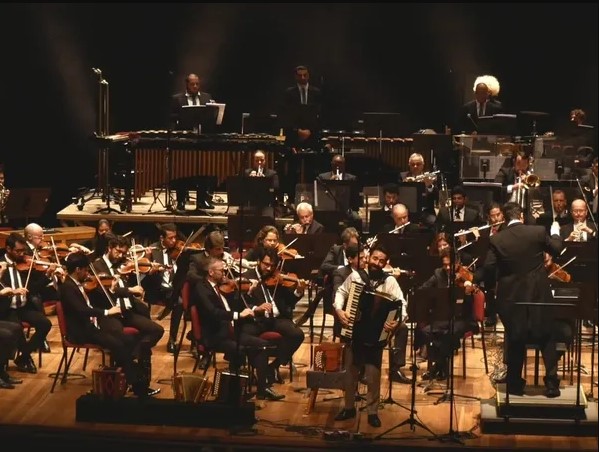
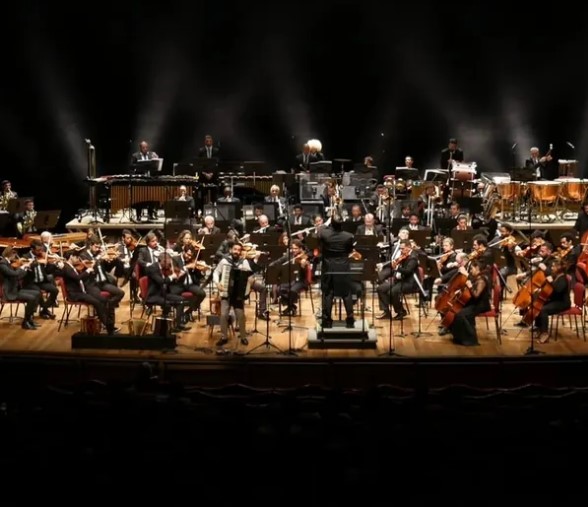
III – BRAZIL IN FLAMES / IN SEARCH OF A CURE
I wrote this with smoke in my lungs and sadness in my chest.
The fires in the Amazon and Pantanal burned not only trees and animals, but a part of our souls.
The bandoneon screams—prayerful, wounded.
Strings tremble like flames.
Flutes transform into birds in flight.
Clarinets sob in the branches.
Trombones and violas moan like homeless animals.
"Imbalance in Nature."
Then silence.
"The Extinction of Species."
The bandoneon stands alone.
The strings whisper behind it, a ghost of the forest that once was.
Trumpets and flutes offer a final birdsong, soon swallowed by absence.
A ternary theme unfolds—beautiful, tremulous.
"The Rose of Cairo."
A rose that cannot bloom.
A warning that we too can disappear.
Then—
"Gaia's Healing."
Hope returns. Fragile. Possible.
The orchestra fills with warmth, as if the Earth itself were breathing light again.
And finally—
"In Search of Healing."
The accordion now glows with optimism, its melody a path forward.
In the Cadenza, I let go—improvising, exploring, bringing the unknown to life.
The orchestra gathers again—pulsing, intertwining, building.
The accordion advances in tireless sixteenth notes,
as if chasing a horizon we still believe in.
And finally, the final measures arrive—
bathed in GLORY.
bathed in TRIUMPH.
bathed in HOPE.
Brazilian Symphony Orchestra
João Pedro Teixeira, soloist
Miguel Campos Neto, conductor
“ASA BRANCA“ - THE ANTHEM OF THE BACKLANDS
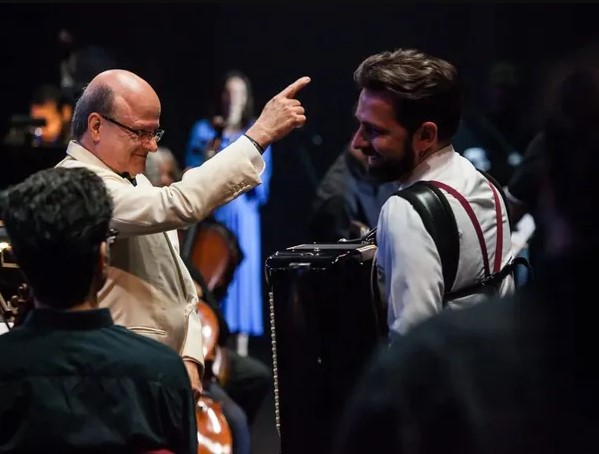
João Pedro Teixeira with the great Brazilian conductor Roberto Tibiriçá and the wonderful Minas Gerais Symphony Orchestra - Brazil
“Asa Branca” – The Anthem of the Blacklands
Composed on March 3, 1947, by Luiz Gonzaga and Humberto Teixeira, Asa Branca is more than a song—it is the soul of the Brazilian Northeast set to music. It was born from the red dust of the drought-stricken sertão, where cracked earth and empty skies force entire families to abandon their homeland in search of survival.
At its core lies a powerful metaphor: the asa-branca, or white-winged dove—a bird that flees the land when the rains fail. In the song, it becomes a symbol for the people of the sertão, spreading its wings and leaving everything behind. Their migration is not a choice, but a cry for life.
Gonzaga's accordion weeps with the sadness of absence, while his voice carries the pain and resilience of a people who refuse to forget where they came from. Asa Branca became an anthem—a cry of longing and, at the same time, a lullaby of hope.
But the story doesn't end there. Years later, Gonzaga and Teixeira wrote its companion: "A Volta da Asa Branca." The rains fall again, the bird flies home, and the people follow. The cycle of exile and reunion, despair and rebirth, is complete.
Over the decades, Asa Branca has been reinterpreted by countless artists, transcending time and borders. Its melody is simple yet timeless; its message, local and universal.
To this day, it remains a living voice of the sertão—a reminder that even in the driest season, there is the promise of rain.
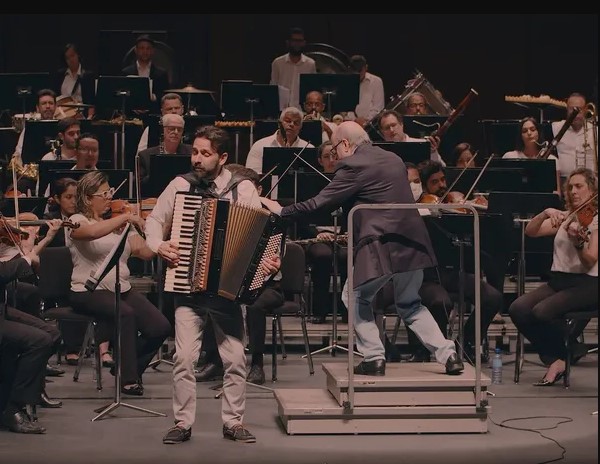
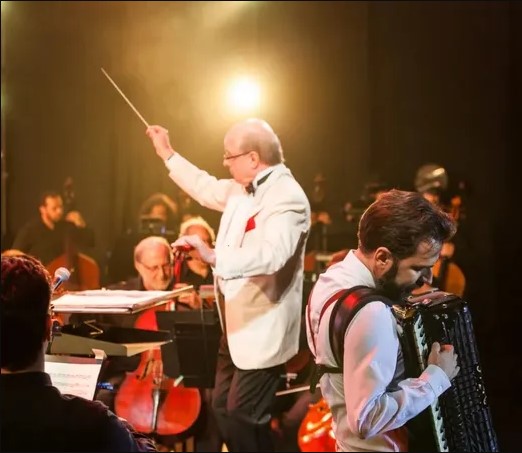
João Pedro – The Voice of the Northeast Accordion
João Pedro Teixeira is an accordionist, composer, and passionate guardian of the musical soul of the Brazilian Northeast. Born into a cultural landscape where music flows as naturally as speech, João Pedro became one of the most expressive voices of his generation, channeling the rhythms, melodies, and ancestral stories of his land through the bellows of his instrument.
Roots in the Sertão
From an early age, João Pedro immersed himself in the traditional sounds of the sertão. The accordion, ubiquitous in festivals, processions, and everyday life in the Northeast, became his companion—not just an instrument, but a vehicle of memory and emotion.
He grew up listening to legends: Luiz Gonzaga, the King of Baião; Dominguinhos, with his lyrical phrasing; Oswaldinho do Acordeon, a technical genius. Inspired by these masters, João Pedro began to forge his own path—rooted in tradition, but with an unmistakably contemporary voice.
Forró and Beyond
Deeply devoted to the forró tradition—which encompasses baião, xote, and xaxado—João Pedro not only preserved these styles but also expanded their expressive range. His performances are marked by rhythmic precision, melodic invention, and profound emotional depth.
But his music is not limited to the confines of traditional forró. João Pedro is known for fusing classical elements, jazz harmonies, and orchestral textures in his work—most notably in his composition "SINFONIA UNEXPEADA," a concerto for accordion and orchestra divided into three movements: A Pandemia, Herança Africana, and Brasil em Chamas / Em Busca de uma Cura. This monumental work reflects his vision of the accordion not only as a folk instrument, but as a symphonic force capable of expressing complex narratives and universal emotions.
Cultural Ambassador
More than an artist, João Pedro is a cultural ambassador. He has brought the music of the Northeast throughout Brazil and abroad, performing on national stages, collaborating with artists from diverse genres, and educating new audiences about the rich history behind each rhythm and melody.
Whether playing a classic like Asa Branca, reimagining the soundscape of Maracatu, or composing for a full orchestra, João Pedro always returns to the essence of his musical identity: the voice of the people, the sound of the sertão, and the pulse of the accordion. Through performances, compositions, and collaborations, he continues to celebrate the dignity of Northeastern life, the richness of Brazilian folklore, and the power of music as testimony and transformation.
Maestro Roberto Tibiriçá
A distinguished figure in Brazilian classical music, he has been instrumental in bridging the gap between classical and popular music. His collaboration with accordionist João Pedro on the "Asa Branca Symphonic Concerto" is a testament to this fusion. This composition is part of Teixeira's album "Acordeão e Orquestra," released in December 2023.
This concerto, orchestrated by the legendary Sivuca, reimagines Luiz Gonzaga's iconic "Asa Branca" within a symphonic framework. Under Tibiriçá's baton, the performance captures the essence of Northeastern Brazil, intertwining the accordion's moving chords with the orchestra's rich textures. João Pedro Teixeira's emotive accordion playing lends authenticity and depth to the piece, paying homage to the cultural roots of forró and baião.
The collaboration was highlighted during the 50th anniversary of the Aquarius Project, a cultural initiative that aims to democratize classical music in Brazil. The event, held at Praça Mauá in Rio de Janeiro, showcased the harmonious blend of classical and popular music traditions, with Tibiriçá conducting the Brazilian Symphony Orchestra and João Pedro Teixeira captivating the audience with his performance.
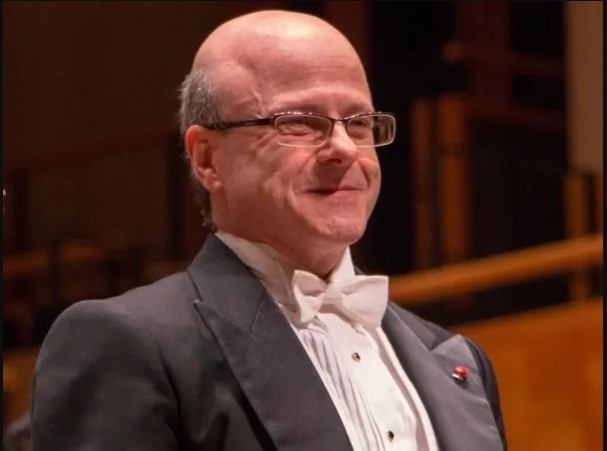
Minas Gerais Symphony Orchestra
João Pedro Teixeira, soloist
Roberto Tibiriçá, conductor
GONZAGIAN RHAPSODY
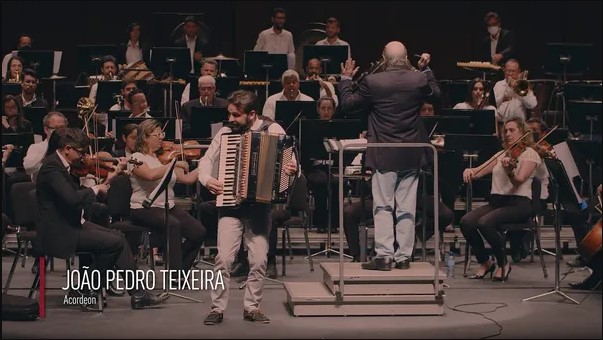
In his moving performance of "Rapsódia Gonzagueana," João Pedro pays a luminous and passionate tribute to Luiz Gonzaga, Brazil's revered King of Baião, where his expressive accordion becomes the soul of an enveloping symphonic tapestry, echoing the vibrant rhythms and heartfelt poetry of the Northeast.
Gonzaga Rhapsody
This rhapsody interweaves themes, rhythms, and emotional landscapes inspired by Gonzaga's vast repertoire—from the iconic Asa Branca to the syncopated swing of Baião, Xote, and Xaxado. João Pedro masterfully blends the roots of forró with classical orchestration, creating a reverent and innovative work.
The piece often features the accordion as its central voice—not only in the melody, but also in the narrative—evoking the life of the sertanejo, the hardships of drought, the hope of migration, and the joy of community celebration.
“Gonzaga Rhapsody” is more than a tribute. It is João Pedro's musical love letter to Gonzaga, transforming traditional Northeastern elements into symphonic grandeur, keeping the sertanejo pulse alive and dancing.
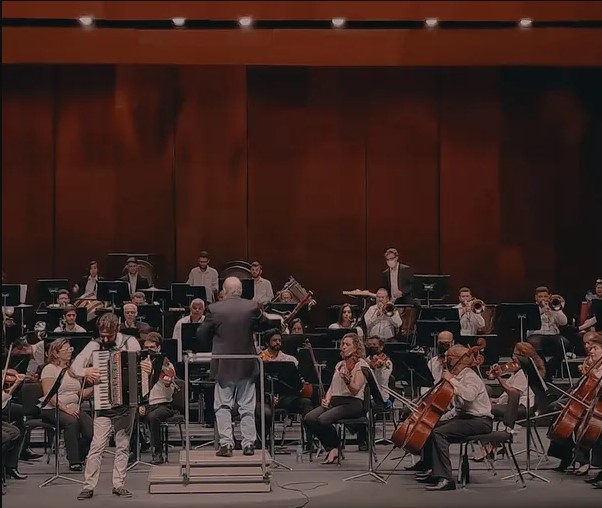
The Gonzaguean Rhapsody unfolds in a single, continuous movement, but traverses multiple thematic landscapes:
Introduction – “Sertão Desperta”
The piece opens with a sparse, evocative accordion melody that evokes the arid landscapes of the sertão. This creates a contemplative mood, transporting the listener to the heart of the Northeast.
Baião Festival
Transitioning into a lively baião rhythm, the composition pays direct homage to Gonzaga's signature style. Syncopated rhythms and call-and-response patterns between the accordion and strings evoke the communal spirit of traditional forró gatherings.
Xote Interlude – “Saudade”
A slower, more lyrical section introduces the xote rhythm, conveying themes of longing and nostalgia. Here, the interplay between wind instruments and the accordion creates a delicate dialogue, reflecting the emotional depth of Gonzaga's ballads.
Finale – “Festa no Sertão”
The rhapsody culminates in a vibrant and festive finale, incorporating elements of xaxado and other regional dances. The full orchestra joins in, creating a jubilant soundscape that pays homage to the enduring vitality of Northeastern music.
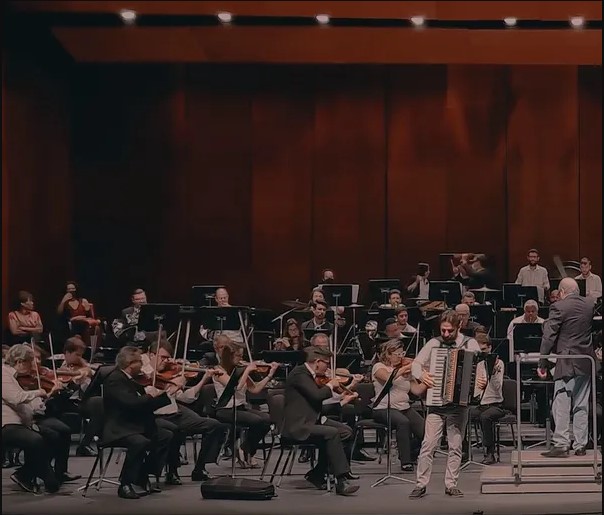
"Rapsódia Gonzaga" is a symphony that pays homage to the legacy of Luiz Gonzaga, the King of Baião. This composition is part of Teixeira's album Accordion and Orchestra, released in December 2023.
Instrumentation and Performance
Teixeira's orchestration highlights the accordion as both a solo and ensemble instrument, highlighting its versatility. The composition employs traditional orchestral sections—strings, woodwinds, brass, and percussion—integrating regional instruments such as the zabumba and triangle to maintain authenticity.
In its performance, "Rapsódia Gonzagueana" demands technical proficiency and expressive nuances, especially from the accordionist, who navigates complex rhythms and emotive melodies. The piece has been performed in concerts celebrating Brazilian music, often accompanied by visual projections of the landscapes and cultural scenes of the Northeast.
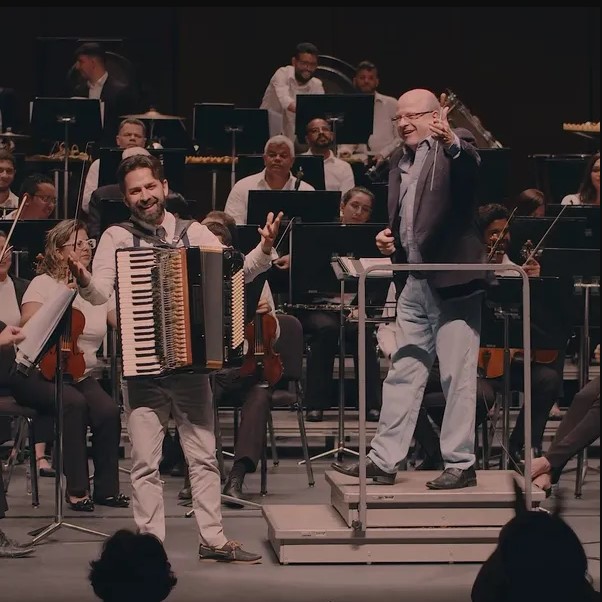
Minas Gerais Symphony Orchestra
João Pedro Teixeira, soloist
Roberto Tibiriçá, conductor
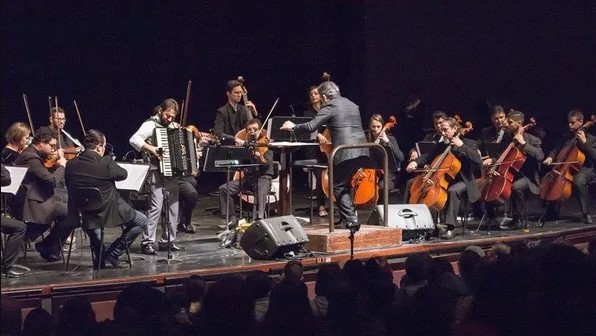
A Tone for Jobim
João Pedro, a virtuoso accordionist deeply rooted in the musical soul of Brazilian music, creates a moving tribute to the timeless art of Antônio Carlos Jobim—the architect of bossa nova, the voice of tranquil oceans and poetic sunsets.
Performed alongside the acclaimed Iguaçu String Orchestra, this piece transcends the boundaries of the genre, inviting listeners into a lyrical conversation between the earthy breath of the accordion and the silky resonance of the orchestra. Here, the sensitivity of Northeastern forró meets the harmonic sophistication of Jobim's legacy, creating a soundscape where longing and celebration coexist.
The arrangement, subtle and expressive, pays homage not only to Jobim's melodic elegance, but also to the deeper emotional tones that permeate his music—longing, hope, nature, and love. Teixeira's accordion sings with reverence and renewal, evoking the essence of Jobim without imitation, offering instead a new color, a new "tone," in the palette of Brazilian music.
Recorded and released in 2017, the piece is part of a broader effort by Teixeira to reimagine and elevate the voice of the accordion in orchestral and classical contexts, uniting traditional Brazilian genres with the sensibility of concert music. The performance was praised for its delicate balance of technical mastery, emotional depth, and innovative arrangement, reinforcing João Pedro Teixeira's status as a reference in contemporary Brazilian music.
ACCORDION AND STRING ORCHESTRA - A TONE FOR JOBIM
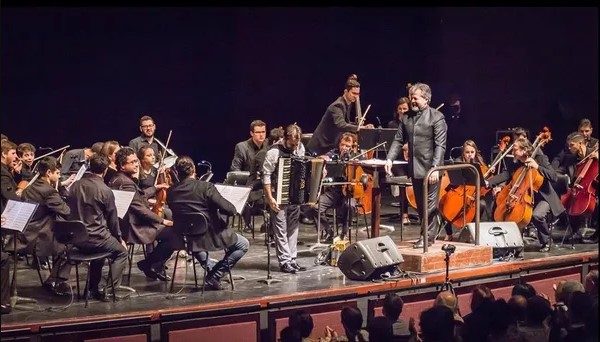
João Pedro Teixeira and his expressive accordion dancing with orchestral grace in a sincere tribute to the timeless genius of Tom Jobim.
"A Tone for Jobim" is João Pedro's heartfelt tribute to one of Brazil's most revered musical minds: Antônio Carlos Jobim. Fusing the lyricism of the Brazilian melodic tradition with the elegance of classical orchestration, Teixeira creates a work that exudes both reverence and innovation.
This composition is not simply a pastiche of bossa nova tropes. It is, rather, a dialogue—between Jobim's lush harmonic landscapes and the expressive depth of the accordion, an instrument deeply rooted in the Brazilian popular soul. Teixeira reimagines Jobim's aesthetic through a new lens, where the textures of the string orchestra gently swirl around the warm breath of the accordion's bellows.
The piece unfolds in a single, fluid movement, echoing the impressionistic flow of Jobim's own harmonic narratives. It opens with a gentle introduction, where suspended string harmonies create an atmosphere of haze and memory. The accordion enters not with extravagance, but with humility—singing a melody that seems to emerge from a quiet corner of Rio de Janeiro at dusk.
From there, the work unfolds in waves. Rhythmic figures reminiscent of samba-canção pulsate beneath soaring string lines, while the accordion weaves in and out of the textures—sometimes as a soloist, sometimes as a complementary voice in a lush ensemble. There are echoes of Águas de Março, Luiza, and Falando de Amor, not as quotations, but as ghostly inspirations hovering in the harmony and phrasing.
Teixeira's orchestration is transparent and welcoming, allowing each musical gesture to breathe. Subtle pizzicatos evoke the swaying of palm trees; long, legato string lines recall the endless horizon of the ocean. A short cadenza midway through the piece gives the accordion a moment of introspection—like a whispered conversation with the spirit of Jobim.
In its final bars, Um Tom para Jobim doesn't seek a dramatic climax. Instead, it gently returns to the initial atmosphere, like the tide receding on the shore of Ipanema. The final chord, suspended and unresolved, leaves us not with an ending, but with longing—a longing that only music can fully express.
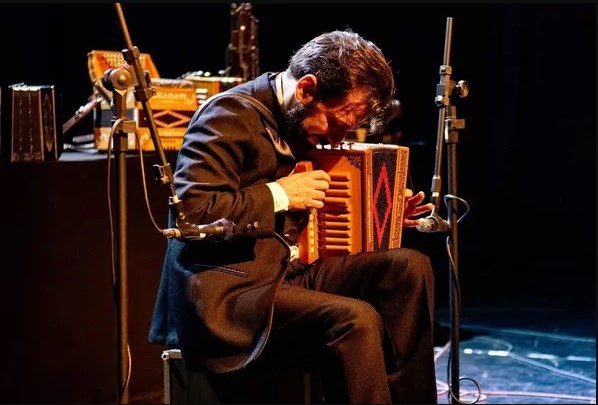
Introduction – Saudade e Sombra
The piece follows an almost rhapsodic structure, meaning it flows freely rather than strictly adhering to classical forms like sonata or rondo. This allows the emotional and thematic development to unfold naturally, evoking the improvisational beauty of Jobim's compositions.
It is built around three main sections, each with distinct textures and emotional arcs:
Introduction – Saudade e Sombra
It begins in a minor key, often with sparse harmonic support from the strings.
The accordion opens with a lyrical line—almost a soliloquy—playing with rubato, creating space and intimacy.
The harmonic language evokes Jobim's use of extended jazz chords (e.g., maj7, 9ths, 13ths), lending lushness to the melancholic tone.
Development – Colors and Paths
A shift to a brighter, more rhythmic middle section, possibly modulating to a relative major.
The orchestra becomes more active here: pizzicato strings mimic the acoustic guitar groove of bossa nova.
The accordion interweaves melodic cells reminiscent of Jobim's famous motifs—think “Onda” or “Fotografia”—but transformed and reinterpreted.
The counterpoint between the orchestral sections (violins, violas, cellos) creates a gentle tapestry of movement, suggesting the rhythmic flow of rivers or coastal breezes.
Recapitulation and Closing – The Tone of a Dream
The return of the opening theme, now with richer orchestration and harmonic coloring.
Accordion and strings join in a more homophonic texture, creating an emotional release. A coda emerges: a final chord disappears into silence, echoing Jobim's characteristic of ending pieces in open or suspended harmonies.
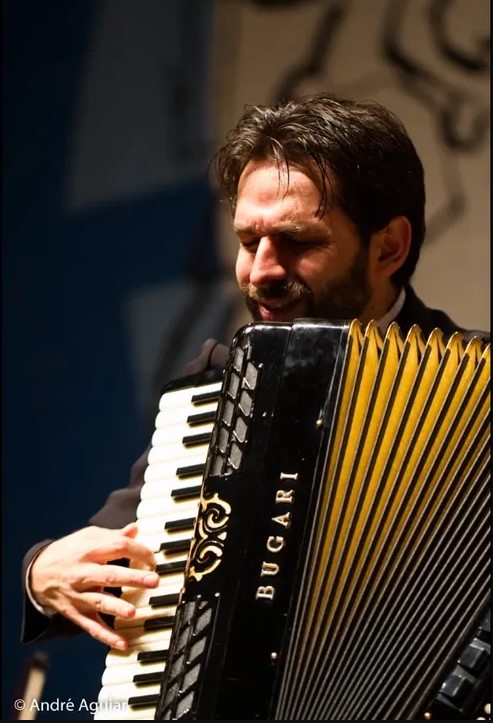
Iguaçu String Orchestra
João Pedro Teixeira, soloist
Paulo Torres, conductor
